Sony KDL-32D3010, KDL-46D3010, KDL-40D3010 User Manual

3-096-727-51(4)
K
LCD Digital Colour TV
Operating Instructions |
|
GB |
|
Before operating the TV, please read the “Safety |
|
||
information” section of this manual. |
|
||
Retain this manual for future reference. |
|
||
Инструкция по эксплуатации |
|
|
|
RU |
|||
 Перед включением телевизора прочтите раздел “Сведения по безопасности” этого руководства.
Перед включением телевизора прочтите раздел “Сведения по безопасности” этого руководства.
Сохраняйте данное руководство для справок в будущем.
Instrukcja obsługi |
|
PL |
Przed rozpoczęciem eksploatacji telewizora należy zapoznać się z treścią rozdziału „Informacje dotyczące bezpieczeństwa” niniejszej instrukcji.
Zachować instrukcję do wykorzystania w przyszłości.
KDL-46D3000/46D3010
KDL-40D3000/40D3010
KDL-32D3000/32D3010

 For useful information about Sony products
For useful information about Sony products
Для получения полезной информации о продукции Сони
Szczegółowe informacje o produktach Sony
© 2007 Sony Corporation
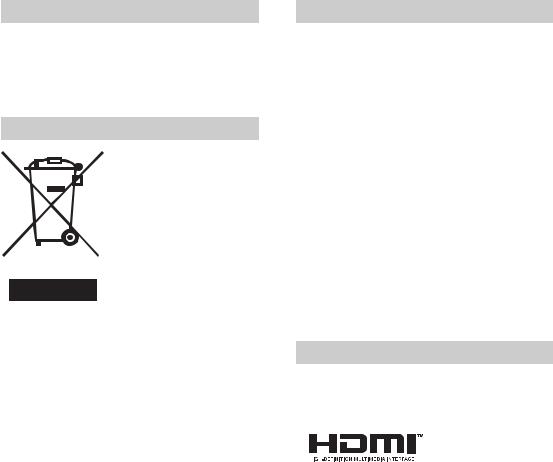
Introduction
Thank you for choosing this Sony product. Before operating the TV, please read this manual thoroughly and retain it for future reference.
Disposal of the TV set
Disposal of Old Electrical & Electronic Equipment (Applicable in the European Union and other European countries with separate collection systems)
This symbol on the product or on its packaging indicates that this product shall not be treated as household waste. Instead it shall be handed over to the applicable collection point for the recycling of electrical and electronic
equipment. By ensuring this product is disposed of correctly, you will help prevent potential negative consequences for the environment and human health, which could otherwise be caused by inappropriate waste handling of this product. The recycling of materials will help to conserve natural resources. For more detailed information about recycling of this product, please contact your local Civic Office, your household waste disposal service or the shop where you purchased the product.
Notice for Digital TV function
•Any functions related to Digital TV ( ) will only work in countries or areas where DVB-T (MPEG2) digital terrestrial signals are broadcast or where you have access to a compatible DVB-C (MPEG2) cable service. Please confirm with your local dealer if you can receive a DVB- T signal where you live or ask your cable provider if their DVB-C cable service is suitable for integrated operation with this TV.
) will only work in countries or areas where DVB-T (MPEG2) digital terrestrial signals are broadcast or where you have access to a compatible DVB-C (MPEG2) cable service. Please confirm with your local dealer if you can receive a DVB- T signal where you live or ask your cable provider if their DVB-C cable service is suitable for integrated operation with this TV.
•The cable provider may charge an additional fee for such services and you may be required to agree to their terms and conditions of business.
•Although this TV set follows DVB-T and DVB-C specifications, compatibility with future DVB-T digital terrestrial and DVB-C digital cable broadcasts cannot be guaranteed.
•Some Digital TV functions may not be available in some countries/regions and DVB-C cable may not operate correctly with some providers.
For a list of compatible cable providers, refer to the support web site:
http://support.sony-europe.com/TV/DVBC
Trademark information
• is a registered trademark of the DVB Project
is a registered trademark of the DVB Project
•HDMI, the HDMI logo and High-Definition Multimedia Interface are trademarks or registered trademarks of HDMI Licensing LLC.
The illustrations used in this manual are of the KDL40D3000 unless otherwise stated.
2 GB

Table of Contents
Start-up Guide |
4 |
|
|
|
|
|
|
Safety information ..................................................................................................................... |
7 |
|
|
Precautions ............................................................................................................................... |
8 |
|
|
Overview of the remote .......................................................................................................... |
9 |
|
|
Overview of the TV buttons and indicators ........................................................................ |
10 |
|
|
|
|
|
|
Watching TV |
|
|
|
Watching TV............................................................................................................................ |
11 |
|
|
Checking the Digital Electronic Programme Guide (EPG) .............................................. |
13 |
|
|
Using the Digital Favourite list ........................................................................................ |
15 |
|
|
|
|
|
|
Using Optional Equipment |
|
|
|
Connecting optional equipment............................................................................................... |
16 |
|
|
Viewing pictures from the connected equipment .................................................................... |
18 |
|
|
Using HDMI control |
19 |
|
|
GB |
|||
|
|
|
|
Using MENU Functions |
|
|
|
Navigating through menus ...................................................................................................... |
20 |
|
|
Picture menu ........................................................................................................................... |
21 |
|
|
Sound menu............................................................................................................................ |
23 |
|
|
Screen menu........................................................................................................................... |
25 |
|
|
Set-up menu............................................................................................................................ |
26 |
|
|
PC Settings menu ................................................................................................................... |
30 |
|
|
Analogue Set-up menu ........................................................................................................... |
31 |
|
|
Digital Set-up menu ........................................................................................................ |
34 |
|
|
|
|
|
|
Additional Information |
|
|
|
Specifications .......................................................................................................................... |
37 |
|
|
Troubleshooting ...................................................................................................................... |
39 |
|
|
 : for digital channels only
: for digital channels only
3 GB
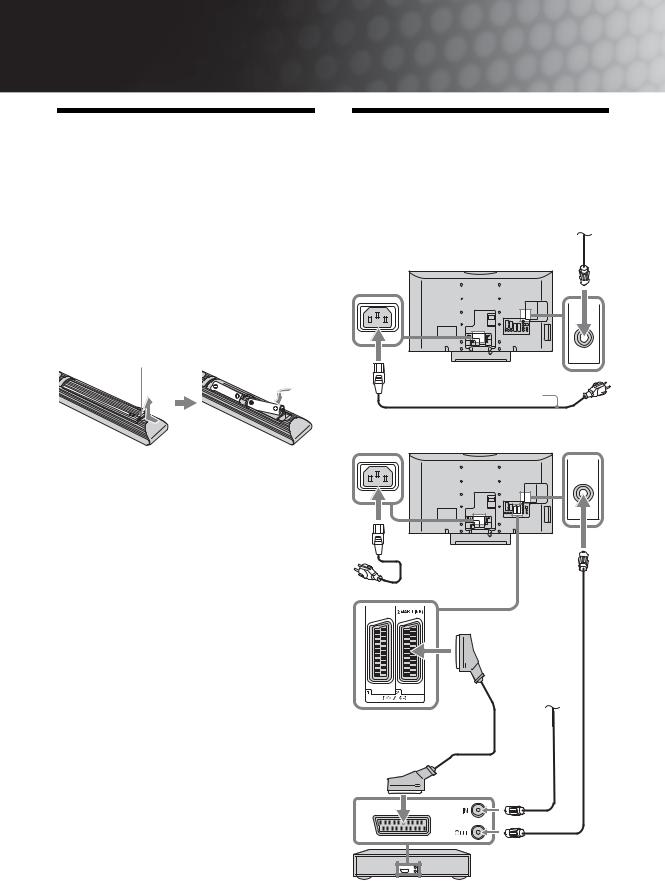
Start-up Guide
1: Checking the accessories
Mains lead (Type C-6)* (1)
Coaxial cable (1)
Support belt (1) and screws (2)
Remote RM-ED009 (1)
Size AA batteries (R6 type) (2)
* For models with ferrite cores, do not remove these cores.
To insert batteries into the remote
Push and lift the cover to open.
~
•Observe the correct polarity when inserting batteries.
•Do not use different types of batteries together or mix old and new batteries.
•Dispose of batteries in an environmentally friendly way. Certain regions may regulate the disposal of batteries. Please consult your local authority.
•Handle the remote with care. Do not drop or step on it, or spill liquid of any kind onto it.
•Do not place the remote in a location near a heat source, a place subject to direct sunlight, or a damp room.
2: Connecting an aerial/ cable/VCR
Connecting an aerial/cable
Terrestrial signal or cable
Coaxial cable (supplied) 
Mains lead (supplied)
Connecting an aerial/cable and VCR
 Mains lead (supplied)
Mains lead (supplied)
Coaxial cable  (supplied)
(supplied)
Terrestrial signal or cable
Scart lead (not supplied) 
Coaxial cable  (not supplied)
(not supplied)
VCR |
4 GB
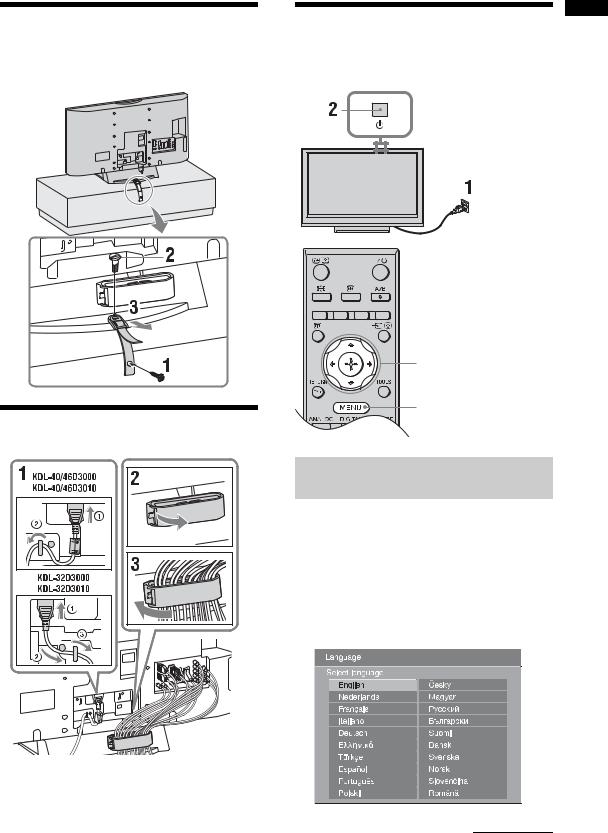
3: Preventing the TV |
5: Performing the initial |
from toppling over |
setup |
3,4,6,7
9
4: Bundling the cables
Selecting the language and country/ region
1 Connect the TV to your mains socket
(220-240 V AC, 50 Hz).
2 Press 1 on the top edge of the TV.
When you turn on the TV for the first time, the Language menu appears on the screen.
3 Press F/f/G/g to select the language displayed on the menu screens, then press
 .
.
Guide up-Start
Continued
5 GB
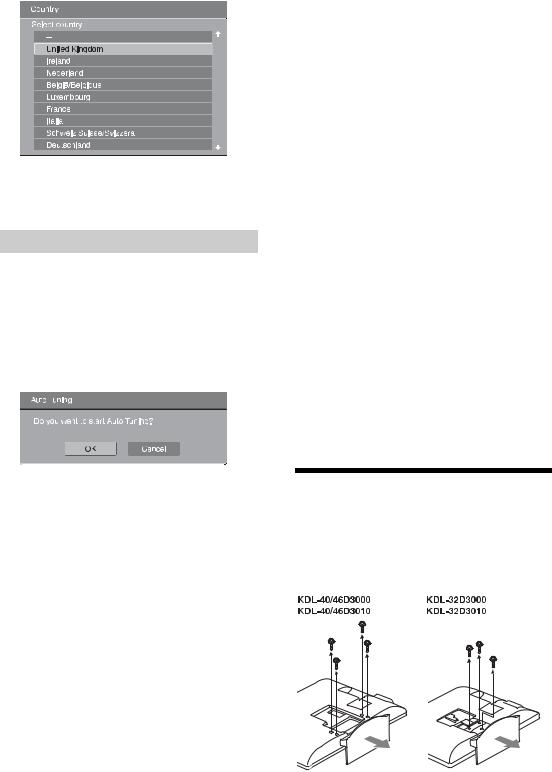
4 Press F/f to select the country/region in which you will operate the TV, then press  .
.
If the country/region which you want to use on the TV does not appear in the list, select “-” instead of a country/region.
Auto-tuning the TV
5 Before you start auto-tuning the TV, insert a pre-recorded tape into the VCR connected to the TV (page 4) and start play back.
The video channel will be located and stored on the TV during auto-tuning.
If no VCR is connected to the TV, skip this step.
6 Press G/g to select “OK”, then press  .
.
7 Press F/f to select “Antenna” or “Cable”, then press  .
.
If you select “Cable”, the screen for selecting the scan type appears. See “To tune the TV for digital cable connection” on page 6.
The TV starts searching for all available digital channels, followed by all available analogue channels. This may take some time, so do not press any buttons on the TV or remote while proceeding.
If a message appears for you to confirm the aerial connection
No digital or analogue channels were found. Check all the aerial connections and press  to start auto-tuning again.
to start auto-tuning again.
8 When the Programme Sorting menu appears on the screen, follow the steps of “Programme Sorting” on page 31.
If you do not wish to change the order in which the analogue channels are stored on the TV, go to next step.
9 Press MENU to exit.
The TV has now tuned in all the available channels.
~
When a digital broadcast channel cannot be received, or when selecting a region in which there are no digital broadcasts in step 4 (page 6), the time must be set after performing step 9.
To tune the TV for digital cable connection
1 Press F/f to select “Scan Type”, then press  .
.
2 Press F/f to select “Quick Scan” or “Full Scan”, then press  .
.
“Quick Scan”: Channels are tuned according to the cable provider’s information within the broadcast signal. The recommended setting for “Frequency”, “Network ID” and “Symbol Rate” is “Auto” unless your cable provider has supplied actual values to use. “Quick Scan” is recommended for fast tuning when this is supported by your cable provider.
“Full Scan”: All available channels are tuned and stored. This procedure may take some time. This option is recommended when “Quick Scan” is not supported by your cable provider.
For further information about supported cable providers, refer to the support web site: http://support.sony-europe.com/TV/DVBC
3 Press G/g/f to select “Start”.
The TV starts searching for channels. Do not press any buttons on the TV or remote.
~
Some cable providers do not support “Quick Scan”. If no channels are detected using “Quick Scan”, perform “Full Scan”.
Detaching the TableTop Stand from the TV
~
Do not remove the Table-Top Stand for any reason other than to wall-mount the TV.
6 GB
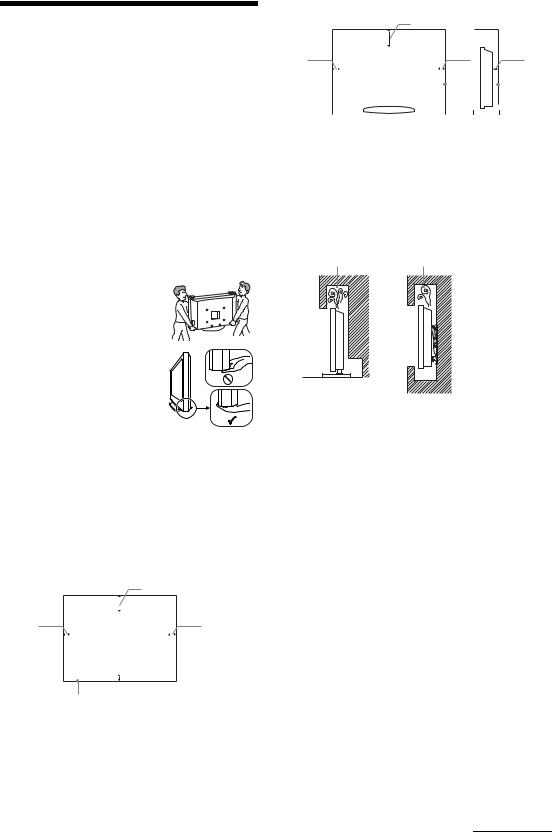
Safety information
Installation/Set-up
Install and use the TV set in accordance with the instructions below in order to avoid any risk of fire, electrical shock or damage and/or injuries.
Installation
•The TV set should be installed near an easily accessible mains socket.
•Place the TV set on a stable, level surface.
•Only qualified service personnel should carry out wall installations.
•For safety reasons, it is strongly recommended that you use Sony accessories, including:
– Wall-mount bracket SU-WL500
Transporting
• Before transporting the TV set, disconnect all cables.
• Two or three people are needed to transport a large TV set.
• When transporting the TV set by hand, hold it as shown on the right.
• When lifting or moving the TV set, hold it firmly from the bottom. Do not put stress on the LCD panel.
• When transporting the TV set, do not subject it to jolts or excessive vibration.
•When transporting the TV set for
repairs or when moving, pack it using the original carton and packing material.
Ventilation
•Never cover the ventilation holes or insert anything in the cabinet.
•Leave space around the TV set as shown below.
•It is strongly recommended that you use a Sony wallmount bracket in order to provide adequate air-circulation.
Installed on the wall
30 cm
10 cm |
|
|
|
|
|
10 cm |
||
|
|
|
|
|
||||
|
|
|
|
|
|
|
|
|
|
|
|
|
|
|
|
|
|
|
|
|
|
|
|
|
|
|
 10 cm
10 cm
Leave at least this space around the set.
Installed with stand
30 cm
10 cm |
|
|
|
|
|
10 cm |
|
|
|
|
|
6 cm |
|||||
|
|
|
|||||||||||||||
|
|
|
|
|
|
|
|
|
|
|
|
|
|
|
|
|
|
|
|
|
|
|
|
|
|
|
|
|
|
|
|
|
|
|
|
|
|
|
|
|
|
|
|
|
|
|
|
|
|
|
|
|
|
|
|
|
|
|
|
|
|
|
|
|
|
|
|
|
|
|
|
|
|
|
|
|
|
|
|
|
|
|
|
|
|
|
|
|
|
|
|
|
|
|
|
|
|
|
|
|
|
|
|
|
|
|
|
Leave at least this space around the set.
•To ensure proper ventilation and prevent the collection of dirt or dust:
–Do not lay the TV set flat, install upside down, backwards, or sideways.
–Do not place the TV set on a shelf, rug, bed or in a closet.
–Do not cover the TV set with a cloth, such as curtains, or items such as newspapers, etc.
–Do not install the TV set as shown below.
Air circulation is blocked.
Wall Wall
Mains lead
Handle the mains lead and socket as follows in order to avoid any risk of fire, electrical shock or damage and/or injuries:
–Connect the TV set using a three-wire grounding type mains plug to a mains socket with a protective earthing connection.
–Use only Sony mains leads, not those of other brands.
–Insert the plug fully into the mains socket.
–Operate the TV set on a 220-240 V AC supply only.
–When wiring cables, be sure to unplug the mains lead for your safety and care not to catch your feet on the cables.
–Disconnect the mains lead from the mains socket before working on or moving the TV set.
–Keep the mains lead away from heat sources.
–Unplug the mains plug and clean it regularly. If the plug is covered with dust and it picks up moisture, its insulation may deteriorate, which could result in a fire.
Notes
•Do not use the supplied mains lead on any other equipment.
•Do not pinch, bend, or twist the mains lead excessively. The core conductors may be exposed or broken.
•Do not modify the mains lead.
•Do not put anything heavy on the mains lead.
•Do not pull on the mains lead itself when disconnecting the mains lead.
•Do not connect too many appliances to the same mains socket.
•Do not use a poor fitting mains socket.
Continued
7 GB

Prohibited Usage
Do not install/use the TV set in locations, environments or situations such as those listed below, or the TV set may malfunction and cause a fire, electrical shock, damage and/or injuries.
Location:
Outdoors (in direct sunlight), at the seashore, on a ship or other vessel, inside a vehicle, in medical institutions, near flammable objects (candles, etc).
Environment:
Places that are hot, humid, or excessively dusty; where insects may enter; where it might be exposed to mechanical vibration; unstable locations; near water, rain, moisture or smoke.
Situation:
Do not use when your hands are wet, with the cabinet removed, or with attachments not recommended by the manufacturer. Disconnect the TV set from mains socket and aerial during lightning storms.
Broken pieces:
•Do not throw anything at the TV set. The screen glass may break by the impact and cause serious injury.
•If the surface of the TV set cracks, do not touch it until you have unplugged the mains lead. Otherwise electric shock may result.
When not in use
•If you will not be using the TV set for several days, the TV set should be disconnected from the mains for environmental and safety reasons.
•As the TV set is not disconnected from the mains when the TV set is just turned off, pull the plug from the mains to disconnect the TV set completely.
•However, some TV sets may have features that require the TV set to be left in standby to work correctly.
For children
•Do not allow children to climb on the TV set.
•Keep small accessories out of the reach of children, so that they are not mistakenly swallowed.
If the following problems occur...
Turn off the TV set and unplug the mains lead immediately if any of the following problems occur. Ask your dealer or Sony service centre to have it checked by qualified service personnel.
When:
–Mains lead is damaged.
–Poor fitting of mains socket.
–TV set is damaged by being dropped, hit or having something thrown at it.
–Any liquid or solid object falls through openings in the cabinet.
Precautions
Viewing the TV
•View the TV in moderate light, as viewing the TV in poor light or during long period of time, strains your eyes.
•When using headphones, adjust the volume so as to avoid excessive levels, as hearing damage may result.
LCD Screen
•Although the LCD screen is made with high-precision technology and 99.99% or more of the pixels are effective, black dots may appear or bright points of light (red, blue, or green) may appear constantly on the LCD screen. This is a structural property of the LCD screen and is not a malfunction.
•Do not push or scratch the front filter, or place objects on top of this TV set. The image may be uneven or the LCD screen may be damaged.
•If this TV set is used in a cold place, a smear may occur in the picture or the picture may become dark. This does not indicate a failure. These phenomena disappear as the temperature rises.
•Ghosting may occur when still pictures are displayed continuously. It may disappear after a few moments.
•The screen and cabinet get warm when this TV set is in use. This is not a malfunction.
•The LCD screen contains a small amount of liquid crystal and mercury. The fluorescent tubes used in this TV set also contain mercury. Follow your local ordinances and regulations for disposal.
Handling and cleaning the screen surface/cabinet of the TV set
Be sure to unplug the mains lead connected to the TV set from mains socket before cleaning.
To avoid material degradation or screen coating degradation, observe the following precautions.
•To remove dust from the screen surface/cabinet, wipe gently with a soft cloth. If dust is persistent, wipe with a soft cloth slightly moistened with a diluted mild detergent solution.
•Never use any type of abrasive pad, alkaline/acid cleaner, scouring powder, or volatile solvent, such as alcohol, benzene, thinner or insecticide. Using such materials or maintaining prolonged contact with rubber or vinyl materials may result in damage to the screen surface and cabinet material.
•When adjusting the angle of the TV set, move it slowly so as to prevent the TV set from moving or slipping off from its table stand.
Optional Equipment
Keep optional components or any equipment emitting electromagnetic radiation away from the TV set. Otherwise picture distortion and/or noisy sound may occur.
8 GB
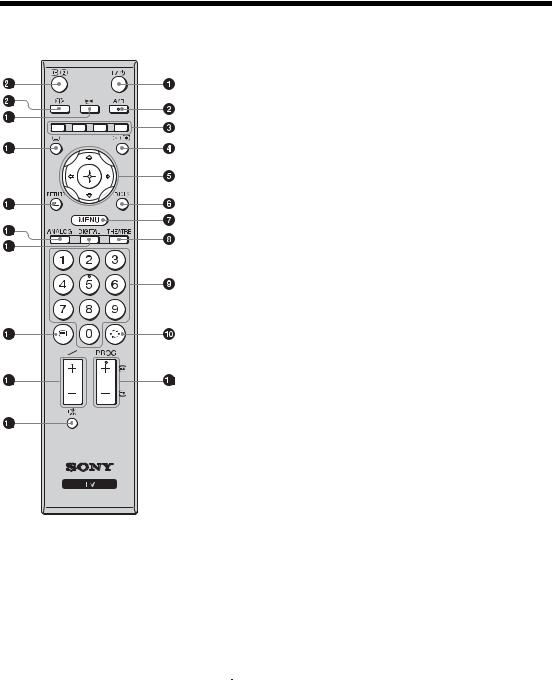
Overview of the remote
z
•The number 5, PROG + and A/B buttons have tactile dots. Use the tactile dots as references when operating the TV.
•If you turn the TV off, Theatre Mode is also turned off.
1"/1 – TV standby
Turns the TV on and off from standby mode.
2 A/B – Dual Sound (page 24)
3 Coloured buttons (page 12, 13, 15)
4 /
/ – Input select / Text hold
– Input select / Text hold
•In TV mode (page 18): Selects the input source from equipment connected to the TV sockets.
•In Text mode (page 12): Holds the current page.
5 F/f/G/g/ (page 11, 20)
(page 11, 20)
6TOOLS (page 12, 18)
Enables you to access various viewing options and change/make adjustments according to the source and screen format.
7 MENU (page 20)
8THEATRE
You can set Theatre Mode on or off. When Theatre Mode is set to on, the optimum audio output (if the TV is connected with an audio system using an HDMI cable) and picture quality for film-based contents are automatically set.
9Number buttons
•In TV mode: Selects channels. For channel numbers 10 and above, enter the second and third digit quickly.
•In Text mode: Enters the three digit page number to select the page.
0 – Previous channel
– Previous channel
Returns to the previous channel watched (for more than five seconds).
qa PROG +/-/ /
/
•In TV mode (page 11): Selects the next (+) or previous (-) channel.
•In Text mode (page 12): Selects the next ( ) or previous (
) or previous ( ) page.
) page.
qs % – Mute (page 11, 18) qd 2 +/- – Volume (page 18) qf /– Text (page 12)
qg DIGITAL – Digital mode (page 11) qh ANALOG – Analogue mode (page 11) qj RETURN /
Returns to the previous screen of any displayed menu.
qk  – EPG (Digital Electronic Programme Guide) (page 13)
– EPG (Digital Electronic Programme Guide) (page 13)
ql  – Picture freeze (page 11)
– Picture freeze (page 11)
Freezes the TV picture.
w;  – Screen mode (page 12) wa
– Screen mode (page 12) wa  /
/ – Info / Text reveal
– Info / Text reveal
•In digital mode: Displays brief details of the programme currently being watched.
•In analogue mode: Displays information such as current channel number and screen format.
•In Text mode (page 12): Reveals hidden information (e.g. answers to a quiz).
9 GB
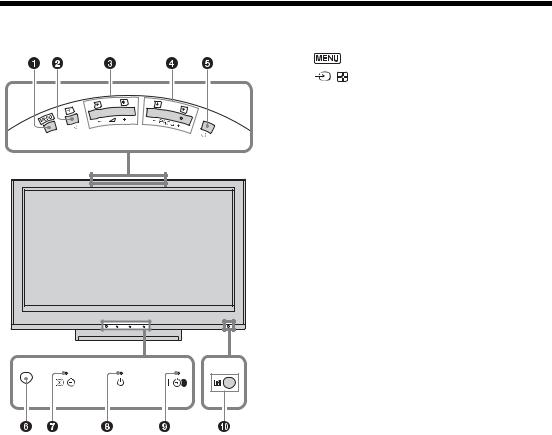
Overview of the TV buttons and indicators
|
|
|
|
|
|
|
|
1 |
(page 20) |
|
|
|
|
|
|
|
|
|
|
2 |
/ – Input select / OK |
|
|
|
|
|
|
|
|
|
||
• In TV mode (page 18): Selects the input source from equipment connected to the TV sockets.
• In TV menu: Selects the menu or option, and confirms the setting.
3 2 +/-/ /
/
• In TV mode: Increases (+) or decreases (-) the volume.
• In TV menu: Moves through the options right ( ) or left (
) or left ( ).
).
4 PROG +/-/ /
/
• In TV mode: Selects the next (+) or previous (-) channel.
• In TV menu: Moves through the options up ( ) or down (
) or down ( ).
).
5 1 – Power
Turns the TV on or off.
~
To disconnect the TV completely, pull the plug from the mains.
6 Light sensor (page 29)
7 
 – Picture Off / Timer indicator
– Picture Off / Timer indicator
8 1 – Standby indicator
Lights up in red when the TV is in standby mode.
9 "  – Power / Timer REC programme indicator
– Power / Timer REC programme indicator
• Lights up in green when the TV is turned on.
• Lights up in orange when the timer recording is set (page 13).
• Lights up in red during the timer recording.
0 Remote control sensor
• Receives IR signals from the remote.
• Do not put anything over the sensor, as its function may be affected.
~
Make sure that the TV is completely turned off before unplugging the mains lead. Unplugging the mains lead while the TV is turned on may cause the indicator to remain lit or may cause the TV to malfunction.
10 GB

Watching TV
Watching TV
2 |
2 |
3
3
1 Press 1 on the top edge of the TV to turn on the TV.
When the TV is in standby mode (the 1 (standby) indicator on the TV front panel is red), press "/1 on the remote to turn on the TV.
2 Press DIGITAL to switch to digital mode, or press ANALOG to switch to analogue mode.
The channels available vary depending on the mode.
3 Press the number buttons or PROG +/- to select a TV channel.
To select channel numbers 10 and above using the number buttons, enter the second and third digits quickly.
To select a digital channel using the Digital Electronic Programme Guide (EPG), see page 13.
In digital mode
An information banner appears briefly. The following icons may be indicated on the banner.
:Radio service
: |
Scrambled/Subscription service |
Watching |
|
|
|||
|
Multiple audio languages available |
|
|
|
Subtitles available |
|
|
: |
Subtitles available for the hearing impaired |
TV |
|
: |
Recommended minimum age for current |
||
|
|||
|
programme (from 4 to 18 years) |
|
|
: |
Parental Lock |
|
|
c (in red): |
|
||
|
Current programme is being recorded |
|
|
Additional operations
To |
Press |
||
|
|
|
|
Freeze the picture |
|
|
. |
|
|||
|
|||
(Picture freeze) |
Press once to remove the small |
||
|
screen, then press again to return |
||
|
to normal TV mode. |
||
|
~ |
||
|
This function is not available for a |
||
|
PC input source. |
||
|
|
|
|
Access the |
. |
||
Programme index |
To select an analogue channel, |
||
table (in analogue |
press F/f, then press . |
||
mode only) |
|
|
|
|
|
|
|
Access the Digital |
. |
||
Favourites (in digital |
For details, see page 15. |
||
mode only) |
|
|
|
|
|
|
|
Mute the sound |
%. |
||
|
Press again to restore. |
||
|
|
|
|
Turn on the TV |
%. |
||
without sound from |
|
|
|
standby mode |
|
|
|
|
|
|
|
Continued
11 GB
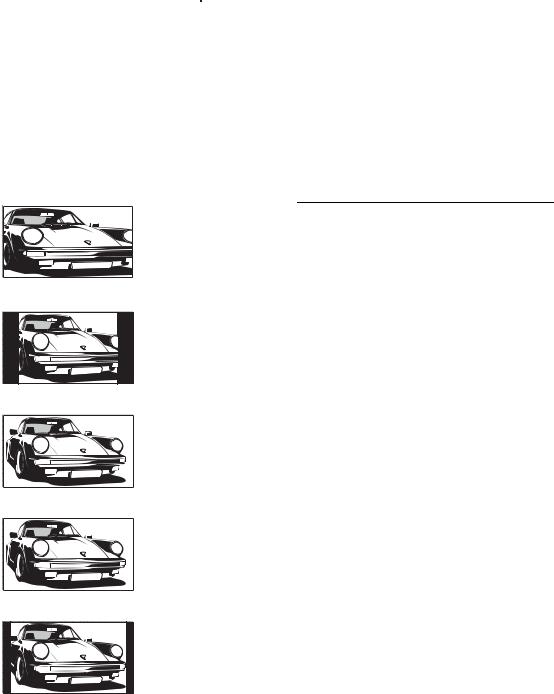
To access Text
Press /. Each time you press /, the display changes cyclically as follows:
Text t Text over the TV picture (mix mode) t No Text (exit the Text service)
To select a page, press the number buttons or  /
/ . To hold a page, press
. To hold a page, press  /
/ .
.
To reveal hidden information, press  /
/ .
.
z
When four coloured items appear at the bottom of the Text page, Fastext is available. Fastext allows you to access pages quickly and easily. Press the corresponding coloured button to access the page.
To change the screen format manually to suit the broadcast
Press  repeatedly to select the desired screen format.
repeatedly to select the desired screen format.
Smart*
4:3 |
Wide |
Displays conventional 4:3 broadcasts with an imitation wide screen effect. The 4:3 picture is stretched to fill the screen.
Displays conventional 4:3 broadcasts (e.g. non-wide screen TV) in the correct proportions.
Displays wide screen (16:9) broadcasts in the correct proportions.
Zoom*
Displays cinemascopic (letter box format) broadcasts in the correct proportions.
14:9* |
Displays 14:9 broadcasts in the correct proportions. As a result, black border areas are visible on the screen.
* Parts of the top and bottom of the picture may be cut off.
~
•You cannot select “4:3” or “14:9” for HD signal source pictures.
•You cannot use this function while the digital banner is displayed.
•Some characters and/or letters at the top and the bottom of the picture may not be visible in “Smart”. In such a case, you can select “Vertical Size” using the “Screen” menu and adjust vertical size to make it visible.
z
•When “Auto Format” is set to “On”, the TV will automatically select the best mode to suit the broadcast (page 25).
•You can adjust the position of the picture when selecting “Smart” (50Hz), “Zoom” or “14:9”. Press F/f to move up or down (e.g. to read subtitles) (except 720p and 1080i).
•Select “Smart” or “Zoom” to adjust for 720p or 1080i source pictures with edge portions cut off.
Using the Tools menu
Press TOOLS to display the following options when viewing a TV programme.
Options |
Description |
|
|
Close |
Closes the Tools menu. |
|
|
Picture Mode |
See page 21. |
|
|
Sound Mode |
See page 23. |
|
|
Motion Enhancer |
See page 26. |
|
|
Speaker |
See page 27. |
|
|
Audio Language (in |
See page 35. |
digital mode only) |
|
|
|
Subtitle Setting (in |
See page 35. |
digital mode only) |
|
|
|
i Volume |
Adjusts the volume of the |
|
headphones. |
|
|
Sleep Timer |
See page 28. |
|
|
Power Saving |
See page 28. |
|
|
Auto Clock Set (in |
Allows you to switch to digital |
analogue mode only) |
mode and obtain the time. |
|
|
System Information (in |
Displays the system |
digital mode only) |
information screen. |
|
|
12 GB
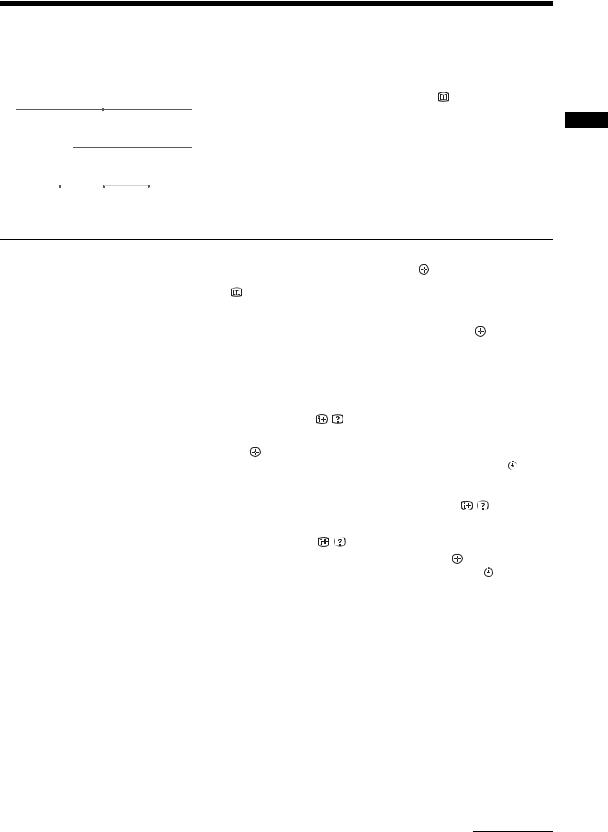
Checking the Digital Electronic Programme Guide (EPG)  *
*
|
|
|
|
|
|
|
|
|
|
|
|
|
|
1 |
In digital mode, press . |
|
|
|
|
|
|
|
|
|
|
|
|
|
|
||
|
|
|
|
|
|
|
|
|
|
|
|
|
|
2 |
Perform the desired operation as shown in |
|
|
|
|
|
|
|
|
|
|
|
|
|
|
||
|
|
|
|
|
|
|
|
|
|
|
|
|
|
||
|
|
|
|
|
|
|
|
|
|
|
|
|
|
|
the following table or displayed on the |
|
|
|
|
|
|
|
|
|
|
|
|
|
|
|
|
|
|
|
|
|
|
|
|
|
|
|
|
|
|
|
screen. |
|
|
|
|
|
|
|
|
|
|
|
|
|
|
|
|
|
|
|
|
|
|
|
|
|
|
|
|
|
|
|
|
|
|
|
|
|
|
|
|
|
|
|
|
|
|
|
|
|
|
|
|
|
|
|
|
|
|
|
|
|
|
|
|
|
|
|
|
|
|
|
|
|
|
|
|
|
|
|
|
|
|
|
|
|
|
|
|
|
|
|
|
|
|
|
|
|
|
|
|
|
|
|
|
|
|
|
|
|
|
|
|
|
|
|
|
|
|
|
|
|
|
|
|
|
|
|
|
Digital Electronic Programme Guide (EPG)
* This function may not be available in some countries/regions.
To |
Do this |
|
|
|
|
||
Watch a programme |
Press F/f to select the programme, then press . |
||
|
|
|
|
Turn off the EPG |
Press . |
|
|
|
|
|
|
Sort the programme information by |
1 |
Press the blue button. |
|
category |
2 |
Press F/f/G/g to select a category, then press . |
|
– Category list |
|
The categories available include: |
|
|
|
||
|
|
“All Categories”: Contains all available channels. |
|
|
|
Category name (e.g. “News”): Contains all channels corresponding to the |
|
|
|
selected category. |
|
|
|
|
|
Set a programme to be recorded |
1 |
Press F/f/G/g to select the future programme you want to |
|
– Timer REC |
|
record, then press |
/ . |
|
2 |
Press F/f to select “Timer REC”. |
|
|
3 |
Press to set the TV and your VCR timers. |
|
|
|
A red c symbol appears by that programme’s information. The |
|
|
|
indicator on the TV front panel lights up in orange. |
|
|
z |
|
|
|
To record the programme you are currently watching, press / . |
||
|
|
|
|
Set a programme to be displayed |
1 |
Press F/f/G/g to select the future programme you want to |
|
automatically on the screen when it |
|
display, then press |
/ . |
starts |
2 |
Press F/f to select “Reminder”, then press . |
|
– Reminder |
A c symbol appears by that programme’s information. The indicator on |
|
|
|
the TV front panel lights up in orange. |
|
~ |
|
If you switch the TV to standby mode, it will automatically turn itself on |
|
when the programme is about to start. |
|
|
TV Watching
Continued
13 GB

To |
Do this |
|
|
Set the time and date of a programme |
1 Press |
/ . |
|
you want to record |
2 Press F/f to select “Manual timer REC”, then press . |
||
– Manual timer REC |
3 |
Press F/f to select the date, then press g. |
|
|
|||
|
4 |
Set the start and stop time in the same way as in step 3. |
|
|
5 |
Press F/f to select the programme, then press . |
|
|
6 |
Press |
to set the TV and your VCR timers. |
|
|
A red c symbol appears by that programme’s information. The |
|
|
|
indicator on the TV front panel lights up in orange. |
|
z
To record the programme you are currently watching, press  /
/ .
.
Cancel a recording/reminder |
1 Press |
/ . |
|
– Timer list |
2 |
Press |
F/f to select “Timer list”, then press . |
|
3 |
Press F/f to select the programme you want to cancel, then |
|
|
|
press . |
|
|
4 |
Press F/f to select “Cancel Timer”, then press . |
|
|
|
A display appears to confirm that you want to cancel the programme. |
|
|
5 |
Press G/g to select “Yes”, then press to confirm. |
|
~
•You can set VCR timer recording on the TV only for SmartLink compatible VCRs. If your VCR is not SmartLink compatible, a message will be displayed to remind you to set your VCR timer.
•Once a recording has begun, you can switch the TV to standby mode, but do not turn off the TV completely or the recording may be cancelled.
•If an age restriction for programmes has been selected, a message asking for a PIN code will appear on the screen. For details, see “Parental Lock” on page 35.
14 GB
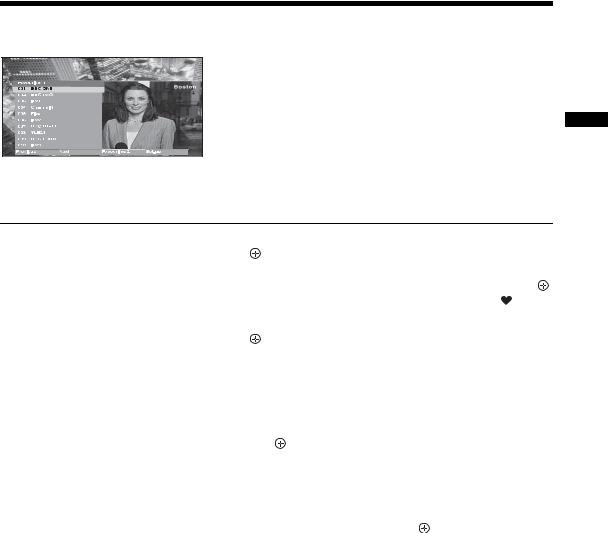
Using the Digital Favourite list  *
*
Digital Favourite list
*This function may not be available in some countries/ regions.
The Favourite feature allows you to specify up to four lists of your favourite programmes.
1 Press MENU.
2 Press F/f to select “Digital Favourites”, then press  .
.
3 Perform the desired operation as shown in the following table or displayed on the screen.
z
Up to 999 channels can be stored in the Favourite list.
To |
Do this |
|
|
Create your Favourite list for the first |
1 |
Press |
to select “Yes”. |
time |
2 |
Press the yellow button to select the Favourite list. |
|
|
3 |
Press F/f to select the channel you want to add, then press . |
|
|
|
Channels that are stored in the Favourite list are indicated by a symbol. |
|
|
|
|
|
Watch a channel |
1 |
Press the yellow button to navigate through your Favourite lists. |
|
|
2 |
Press |
while selecting a channel. |
|
|
||
Turn off the Favourite list |
Press RETURN. |
||
|
|
|
|
Add or remove channels in the currently |
1 |
Press the blue button. |
|
edited Favourite list |
2 |
Press the yellow button to select the Favourite list you want to |
|
|
|
edit. |
|
|
3 |
Press F/f to select the channel you want to add or remove, |
|
|
|
then press . |
|
|
|
|
|
Remove all channels from the current |
1 |
Press the blue button. |
|
Favourite list |
2 |
Press the yellow button to select the Favourite list you want to |
|
|
|
edit. |
|
|
3 |
Press the blue button. |
|
|
4 |
Press G/g to select “Yes”, then press to confirm. |
|
|
|
|
|
TV Watching
15 GB
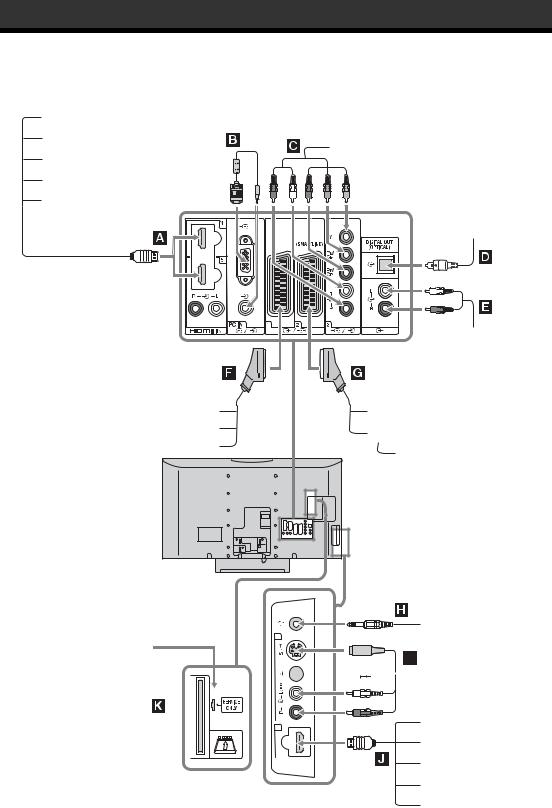
Using Optional Equipment
Connecting optional equipment
You can connect a wide range of optional equipment to your TV.
Audio system |
PC |
|
|
||
DVD player |
|
|
|
|
|
|
|
|
PC (HDMI output)
Blu-ray disc player
Digital video camera
Video game equipment
DVD player
Decoder
6
For service use only
CAM Card 
HDMI IN 7
DVD player with component output
Digital audio (PCM) component
Hi-Fi audio equipment
DVD recorder
VCR
Decoder
Headphones














 S VHS/Hi8/
S VHS/Hi8/
DVC camcorder
PC (HDMI output)
Blu-ray disc player
Digital video camera
Audio system
DVD player
16 GB

Sockets |
Input symbol on |
Description |
|
screen |
|
AHDMI IN 4 or 5 |
AV4, AV5 or |
Connect to the HDMI IN 4, 5 or 7 socket if the equipment has a |
JHDMI IN 7 |
AV7 |
HDMI socket. The digital video and audio signals are input |
from the equipment. In addition, when HDMI control compatible equipment is connected, communication with the connected equipment is supported. Refer to page 28 to set up this communication. If the equipment has a DVI socket, connect the DVI socket to the HDMI IN 5 socket through a DVI - HDMI adaptor interface (not supplied), and connect the equipment’s audio out sockets to the audio in the HDMI IN 5 sockets.
~
•The HDMI sockets only support the following video inputs: 480i, 480p, 576i, 576p, 720p, 1080i, 1080p and 1080/24p.
•Be sure to use only an HDMI cable that bears the HDMI logo.
•When connecting an audio system with HDMI socket, be sure to also connect to the DIGITAL OUT socket.
BPC |
|
/ |
|
|
|
PC |
|
Connect to the PC |
|
/ |
|
|
|
socket. It is recommended to use a |
|||||||||||||
|
|
|
|
|
|||||||||||||||||||||||
|
|
|
|
|
|
|
|
|
|
|
|
|
|
|
|
|
PC cable with ferrites. |
|
|
|
|
||||||
|
|
|
|
|
|
|
|
|
|
|
|
|
|
|
|
|
|
|
|
|
|
|
|
||||
C |
|
|
|
/ 3 |
|
|
AV3 |
|
Connect to the component video sockets and the audio sockets |
||||||||||||||||||
|
|
|
|
|
|
||||||||||||||||||||||
|
|
|
|
|
|
|
|
|
|
|
|
|
|
|
|
|
|
/ 3. |
|
|
|
|
|
|
|
|
|
|
|
|
|
|
|
|
|
|
|
|
|
|
|
|
|
|
|
|
|
|
|
|
|
|
|
|
|
|
|
|
|
|
|
|
|
|
|
|
|
|
|
|
|
|
|
|
|
|
|
|
|
||||
DDIGITAL OUT |
|
|
|
|
|
|
|
Connect to the DIGITAL OUT socket using the Optical audio |
|||||||||||||||||||
(OPTICAL) |
|
|
|
|
|
|
|
|
cable. |
|
|
|
|
|
|
|
|
||||||||||
|
|
|
|
|
|
|
|
|
|
|
|
|
|
|
|
|
~ |
|
|
|
|
|
|
|
|
|
|
|
|
|
|
|
|
|
|
|
|
|
|
|
|
|
|
|
Super Audio CD and DVD Audio sound may not be output |
||||||||||
|
|
|
|
|
|
|
|
|
|
|
|
|
|
|
|
|
depending on the model. |
|
|
|
|
||||||
|
|
|
|
|
|
|
|
|
|
|
|
|
|
|
|
|
|
|
|
|
|
|
|
|
|
||
E |
|
|
|
|
|
|
|
|
|
|
|
|
|
|
Connect to the audio output |
|
|
sockets to listen to the sound |
|||||||||
|
|
|
|
|
|
|
|
|
|
|
|
|
|
|
|
||||||||||||
|
|
|
|
|
|
|
|
|
|
|
|
|
|
|
|
|
from the TV on Hi-Fi audio equipment. |
|
|||||||||
|
|
|
|
|
|
|
|
|
|
|
|
|
|
|
|
|
|
|
|
|
|
|
|
|
|
|
|
F |
/ |
|
|
|
1 |
|
|
AV1 or |
|
|
AV1 |
Connect to the scart |
/ |
|
|
1 socket. When you connect the |
|||||||||||
|
|
|
|
|
|
|
|||||||||||||||||||||
|
|
|
|
|
|
|
|
|
|
|
|
|
|
|
|
|
decoder, the scrambled signal from the TV tuner is output to |
||||||||||
|
|
|
|
|
|
|
|
|
|
|
|
|
|
|
|
|
the decoder, then the unscrambled signal is output from the |
||||||||||
|
|
|
|
|
|
|
|
|
|
|
|
|
|
|
|
|
decoder. |
|
|
|
|
|
|
|
|
||
|
|
|
|
|
|
|
|
|
|
|
|
|
|
|
|
|
|
|
|
|
|
|
|
|
|
|
|
G |
/ |
|
|
|
2 |
|
|
AV2 or |
|
|
AV2 |
Connect to the scart |
/ |
|
|
|
2 socket. SmartLink is a direct |
||||||||||
|
|
|
|
|
|
|
|
||||||||||||||||||||
|
|
|
|
|
|
|
|
|
|
|
|
|
|
|
|
|
link between the TV and a VCR/DVD recorder. |
|
|||||||||
|
|
|
|
|
|
|
|
|
|
|
|
|
|
|
|
|
|
|
|
|
|
|
|
||||
HHeadphones |
|
|
|
|
|
|
|
Connect to the i socket to listen to sound from the TV on |
|||||||||||||||||||
|
|
|
|
|
|
|
|
|
|
|
|
|
|
|
|
|
headphones. |
|
|
|
|
|
|
|
|
||
|
|
|
|
|
|
|
|
|
|
|
|
|
|
|
|
|
|
|
|
|
|
|
|
|
|
||
I |
|
6 or |
6, and |
|
|
AV6 or |
AV6 |
Connect to the S video |
6 socket or the composite video |
||||||||||||||||||
6 |
|
|
|
|
|
|
|
|
|
|
|
|
|
|
|
|
6 socket, and the audio |
|
6 sockets. To avoid picture |
||||||||
|
|
|
|
|
|
|
|
|
|
|
|
|
|
|
|
|
noise, do not connect the camcorder to the video |
6 socket |
|||||||||
|
|
|
|
|
|
|
|
|
|
|
|
|
|
|
|
|
and the S video |
6 socket at the same time. If you connect |
|||||||||
|
|
|
|
|
|
|
|
|
|
|
|
|
|
|
|
|
mono equipment, connect to the 6 L socket. |
|
|||||||||
|
|
|
|
|
|
|
|
|
|
|
|
|
|
|
|
|
|
|
|
|
|
|
|
|
|||
K |
CAM |
|
|
|
|
|
|
|
|
To use pay TV services. For details, refer to the instruction |
|||||||||||||||||
(Conditional Access |
|
|
|
|
|
|
|
manual supplied with your CAM. |
|
||||||||||||||||||
Module) |
|
|
|
|
|
|
|
|
To use the CAM, remove the “dummy” card from the CAM |
||||||||||||||||||
|
|
|
|
|
|
|
|
|
|
|
|
|
|
|
|
|
slot. Turn off the TV when inserting your CAM into the CAM |
||||||||||
|
|
|
|
|
|
|
|
|
|
|
|
|
|
|
|
|
slot. When you do not use the CAM, we recommend that the |
||||||||||
|
|
|
|
|
|
|
|
|
|
|
|
|
|
|
|
|
“dummy” card be inserted and kept in the CAM slot. |
|
|||||||||
~
CAM is not supported in some countries/regions. Check with your authorized dealer.
Equipment Optional Using
17 GB
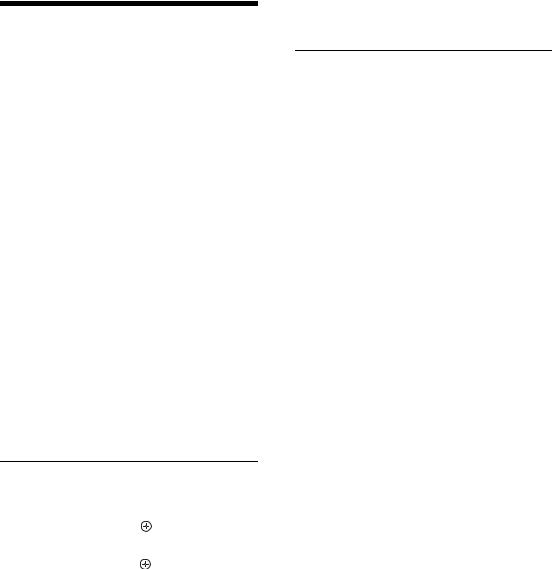
Viewing pictures from the connected equipment
Turn on the connected equipment, then perform one of the following operation.
For equipment connected to the scart sockets using a fully-wired 21-pin scart lead (page 16)
Start playback on the connected equipment.
The picture from the connected equipment appears on the screen.
For an auto-tuned VCR (page 6)
In analogue mode, press PROG +/-, or the number buttons, to select the video channel.
For other connected equipment (page 16)
Press  /
/ to display the connected equipment list. Press F/f to select the desired input source, then press
to display the connected equipment list. Press F/f to select the desired input source, then press  . (The highlighted item is selected if 2 seconds pass without any operation after pressing F/f.)
. (The highlighted item is selected if 2 seconds pass without any operation after pressing F/f.)
When the input source is set to “Skip” in the “AV Preset” menu under the “AV Set-up” menu (page 27), that input does not appear in the list.
Additional operations
To |
Do this |
|
|
Return to normal TV |
Press DIGITAL or ANALOG. |
mode |
|
|
|
Access the Input signal |
Press to access the Input |
index table (except TV |
signal index table. To select an |
mode) |
input source, press F/f, then |
|
press . |
|
|
Change the volume of |
Press 2 +/-. |
the connected HDMI |
|
control compatible |
|
audio system |
|
|
|
Mute the sound of the |
Press %. |
connected HDMI |
Press again to restore. |
control compatible |
|
audio system |
|
|
|
Using the Tools menu
Press TOOLS to display the following options when viewing pictures from connected equipment.
Options |
Description |
|
|
Close |
Closes the Tools menu. |
|
|
Picture Mode (except |
See page 21. |
PC input mode) |
|
|
|
Display Mode (in PC |
See page 21. |
input mode only) |
|
|
|
Sound Mode |
See page 23. |
|
|
Motion Enhancer |
See page 26. |
(except PC input |
|
mode) |
|
|
|
Speaker |
See page 27. |
|
|
PAP (except PC input |
See page 18. |
mode) |
|
|
|
PIP (in PC input |
See page 19. |
mode only) |
|
|
|
Auto Adjustment (in |
See page 30. |
PC input mode only) |
|
|
|
Horizontal Shift (in |
See page 30. |
PC input mode only) |
|
|
|
Vertical Shift (in PC |
See page 30. |
input mode only) |
|
|
|
i Volume |
Adjusts the volume of the |
|
headphones. |
|
|
Sleep Timer (except |
See page 28. |
PC input mode) |
|
|
|
Power Saving |
See page 28. |
|
|
Auto Clock Set |
Allows you to switch to digital |
|
mode and obtain the time. |
|
|
To view two pictures simultaneously
– PAP (Picture and Picture)
You can view two pictures (external input and TV programme) on the screen simultaneously.
Connect the optional equipment (page 16), and make sure that images from the equipment appear on the screen (page 18).
~
•This function is not available for a PC input source.
•You cannot change the size of the pictures.
•You cannot display analog TV video in the TV programme picture while displaying AV1, AV2 or AV6 video in the external input picture.
1 Press TOOLS to display the Tools menu.
18 GB

2 Press F/f to select “PAP”, then press  .
.
The picture from connected equipment is displayed on the left and the TV programme is displayed on the right.
3 Press number buttons or PROG +/- to select the TV channel.
To return to single picture mode
Press  or RETURN.
or RETURN.
z
The picture framed in green is audible. You can switch the audible picture by pressing G/g.
To view two pictures simultaneously
– PIP (Picture in Picture)
You can view two pictures (PC input and TV programme) on the screen simultaneously. Connect a PC (page 16), and make sure that images from a PC appear on the screen.
~
•You cannot display resolutions higher than WXGA (1280 × 768 pixels).
•“Power Management” is not available in PIP mode (page 30).
1 Press TOOLS to display the Tools menu.
2 Press F/f to select “PIP”, then press  .
.
The picture from the connected PC is displayed with full size and the TV programme is displayed on the right corner.
You can use F/f/G/g to move the TV programme screen position.
3 Press number buttons or PROG +/- to select the TV channel.
To return to single picture mode
Press RETURN.
z
You can switch the audible picture by selecting “Audio Swap” from the Tools menu.
Using HDMI control
The HDMI control function allows equipment to control each other using HDMI CEC (Consumer Electronics Control) specified by HDMI.
You can perform interlocked control operations between Sony HDMI control compatible equipment such as a TV, DVD recorder with hard disk and audio system by connecting the equipment with HDMI cables.
Be sure to correctly connect and set the compatible equipment to use the HDMI control function.
To connect the HDMI control compatible equipment
Connect the compatible equipment and the TV with an HDMI cable. When connecting an audio system, in addition to the HDMI cable, be sure to also connect the DIGITAL OUT (OPTICAL) socket of the TV and the audio system using an optical audio cable. For details, see page 16.
To make the HDMI control settings
HDMI control must be set on both the TV side and the connected equipment side. See “HDMI Set-up” on page 28 for the TV side settings. See the operating instructions of the connected equipment for setting details.
HDMI control functions
•Turns the connected equipment off interlocked with the TV.
•Turns the TV on interlocked with the connected equipment and automatically switches the input to the equipment when the equipment starts to play.
•If you turn on a connected audio system while the TV is on, the input switches to the audio from the audio system.
•Adjusts the volume and mutes the sound of a connected audio system.
Equipment Optional Using
19 GB
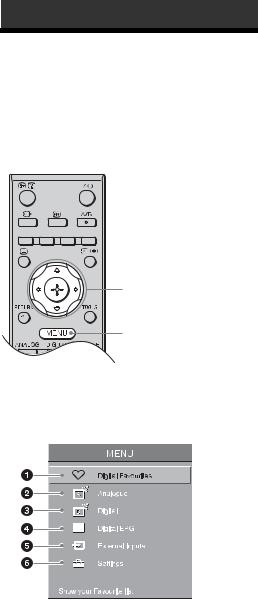
Using MENU Functions
Navigating through menus
“MENU” allows you to enjoy various convenient features of this TV. You can easily select channels or inputs sources and change the settings for your TV.
2
1
1 Press MENU.
2 Press F/f to select an option, then press
 .
.
To exit the menu, press MENU.
1Digital Favourites*
Displays the Favourite list (page 15).
2Analogue
Returns to the last viewed analogue channel.
3Digital*
Returns to the last viewed digital channel.
4Digital EPG*
Displays the Digital Electronic Programme Guide (EPG) (page 13).
5External Inputs
Selects equipment connected to your TV.
•To watch the desired external input, select the input source, then press  .
.
•To assign a label to an external input, select “Edit AV Labels”, then see page 27.
•To see a list of the connected HDMI control compatible equipment, select “HDMI Device Selection”.
6Settings
Displays the “Settings” menu where most of the advanced settings and adjustments are performed.
1Press F/f to select a menu icon, then press  .
.
2Press F/f/G/g to select an option or adjust a setting, then press  .
.
For details about settings, see page 21 to 36.
~
The options you can adjust vary depending on the situation. Unavailable options are greyed out or not displayed.
*This function may not be available in some countries/ regions.
20 GB
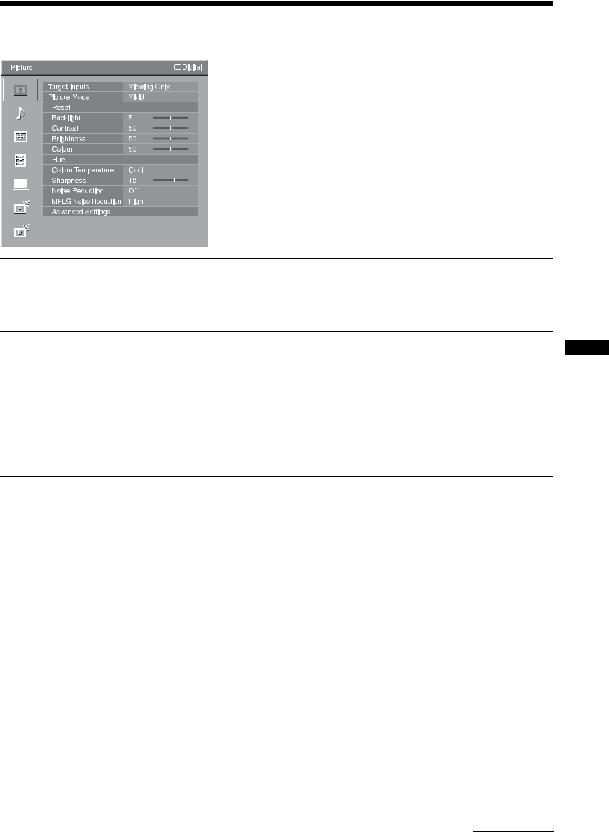
Picture menu
You can select the options listed below on the “Picture” menu. To select options in “Settings”, refer to “Navigating through menus” (page 20).
Target Inputs |
Selects whether to apply settings made in the “Picture” menu to all inputs, or only to |
|
the input currently being watched. |
|
“All”: Applies settings to all inputs. |
|
“Viewing Only”: Applies settings only to the current input. |
Picture Mode
Display Mode
Selects the picture mode except for PC input source. “Vivid”: For enhanced picture contrast and sharpness.
“Standard”: For standard picture. Recommended for home entertainment. “Cinema”: For viewing film-based content. Most suitable for viewing in a theatrelike environment. This picture setting was developed in collaboration with Sony Pictures Entertainment to faithfully reproduce movies as intended by their creators.
Selects the display mode for PC input source. “Video”: For video images.
“Text”: For text, charts or tables.
Reset |
Resets all the “Picture” settings except “Target Inputs”, “Picture Mode” and |
|
“Display Mode” to the factory settings. |
|
|
Backlight |
Adjusts the brightness of the backlight. |
|
|
Contrast |
Increases or decreases picture contrast. |
|
|
Brightness |
Brightens or darkens the picture. |
|
|
Colour |
Increases or decreases colour intensity. |
|
|
Hue |
Increases or decreases the green tones and red tones. |
|
~ |
|
“Hue” can only be adjusted for an NTSC colour signal (e.g. U.S.A. video tapes). |
|
|
Functions MENU Using
Continued
21 GB

Colour Temperature |
Adjusts the whiteness of the picture. |
|
“Cool”: Gives the white colours a blue tint. |
|
“Neutral”: Gives the white colours a neutral tint. |
|
“Warm 1”/“Warm 2”: Gives the white colours a red tint. “Warm 2” gives a redder |
|
tint than “Warm 1”. |
|
z |
|
“Warm 1” and “Warm 2” are not available when “Picture Mode” is set to “Vivid”. |
|
|
Sharpness |
Sharpens or softens the picture. |
|
|
Noise Reduction |
Reduces the picture noise (snowy picture) in a weak broadcast signal. |
|
“Auto”: Automatically reduces the picture noise (in analogue mode only). |
|
“High”/“Medium”/“Low”: Modifies the effect of the noise reduction. |
|
“Off”: Turns off the “Noise Reduction” feature. |
|
|
MPEG Noise Reduction |
Reduces the picture noise in MPEG-compressed video. |
|
|
Advanced Settings |
Customizes the Picture function in more detail. When you set “Picture Mode” to |
|
“Cinema” or “Standard”, you can set/change these settings. |
|
“Reset”: Resets all the advanced settings to the factory settings. |
|
“Black Corrector”: Enhances black areas of the picture for stronger contrast. |
|
“Adv. Contrast Enhancer”: Automatically adjusts “Backlight” and “Contrast” to |
|
the most suitable settings judging from the brightness of the screen. This setting is |
|
especially effective for dark images scenes. It will increase the contrast distinction |
|
of the darker picture scenes. |
|
“Gamma”: Adjusts the balance between bright and dark areas of the picture. |
|
“Clear White”: Emphasizes white colours. |
|
“Live Colour”: Makes colours more vivid. |
|
“Colour Space”: Changes the colour reproduction gamut. “Wide” reproduces the |
|
vivid colour and “Normal” reproduces the standard colour. |
|
|
22 GB
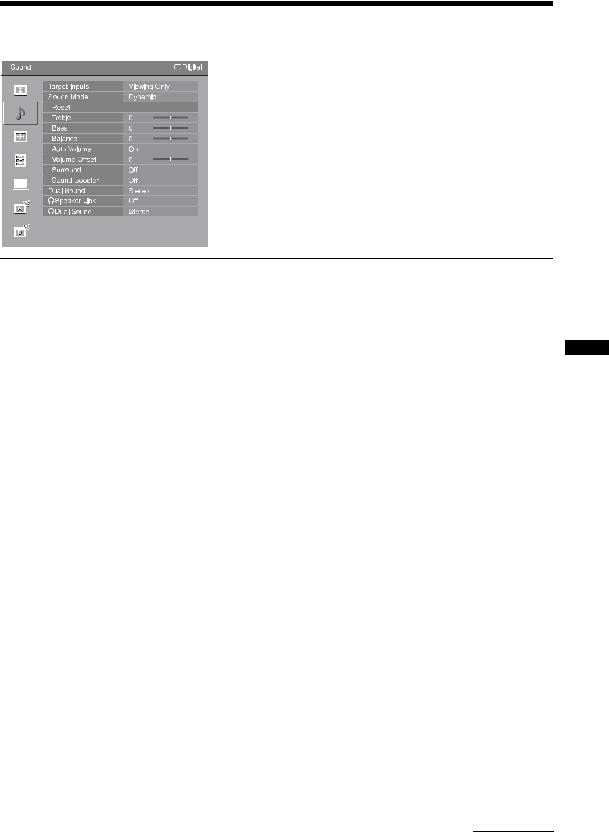
Sound menu
You can select the options listed below on the “Sound” menu. To select options in “Settings”, refer to “Navigating through menus” (page 20).
Target Inputs |
Selects whether to apply settings made in the “Sound” menu to all inputs, or only to |
|
the input currently being watched. |
|
“All”: Applies settings to all inputs. |
|
“Viewing Only”: Applies settings only to the current input. |
|
|
Sound Mode |
“Dynamic”: Enhances treble and bass. |
|
“Standard”: For standard sound. Recommended for home entertainment. |
|
“Custom”: Flat response. Also allows you to store your preferred settings. |
|
|
Reset |
Resets all the “Sound” settings except “Target Inputs”, “Sound Mode”, “Dual |
|
Sound”, “i Speaker Link” and “i Dual Sound” to the factory settings. |
|
|
Treble |
Adjusts higher-pitched sounds. |
|
|
Bass |
Adjusts lower-pitched sounds. |
|
|
Balance |
Emphasizes left or right speaker balance. |
|
|
Auto Volume |
Keeps a constant volume level even when volume level gaps occur (e.g. adverts tend |
|
to be louder than programmes). |
|
|
Volume Offset |
Adjusts the volume level of the current input relative to other inputs, when “Target |
|
Inputs” is set to “Viewing Only”. |
|
|
Surround |
“S-FORCE Front Surround”: Available for normal stereo broadcast and 5.1ch |
|
digital broadcast surround audio, and the audio input from connected equipment. |
|
“Off”: Converts and reproduces 5.1ch and other digital broadcast surround audio as |
|
normal stereo audio (2ch). Reproduces the original audio of other broadcasts as is. |
|
|
Sound Booster |
Gives sound more impact by compensating for phase effects in speakers. |
|
|
Functions MENU Using
Continued
23 GB

Dual Sound |
Selects the sound from the speaker for a stereo or bilingual broadcast. |
|
“Stereo”/“Mono”: For a stereo broadcast. |
|
“A”/“B”/“Mono”: For a bilingual broadcast, select “A” for sound channel 1, “B” |
|
for sound channel 2, or “Mono” for a mono channel, if available. |
|
~ |
|
If you select other equipment connected to the TV, set “Dual Sound” to “Stereo”, “A” or “B”. |
|
However, when the external equipment connected to the HDMI socket is selected, this is fixed |
|
to “Stereo”. |
|
|
i Speaker Link |
Switches the TV’s internal speakers on/off when headphones are connected. |
|
“On”: Sound is output only from headphones. |
|
“Off”: Sound is output from both the TV and headphones. |
|
|
i Dual Sound |
Selects the sound from the headphone for a stereo or bilingual broadcast, which |
|
depends on the “Dual Sound” selection. |
|
|
24 GB
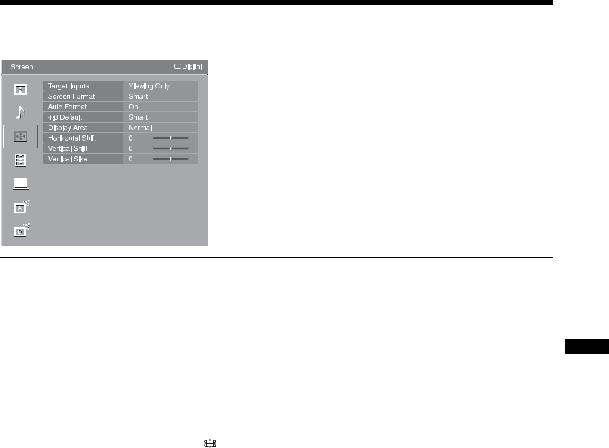
Screen menu
You can select the options listed below on the “Screen” menu. To select options in “Settings”, refer to “Navigating through menus” (page 20).
Target Inputs |
Selects whether to apply settings made in the “Screen” menu to all inputs, or only to |
|
|
the input currently being watched. |
|
|
“All”: Applies settings to all inputs. |
|
|
“Viewing Only”: Applies settings only to the current input. |
|
|
|
|
Screen Format |
For details about the screen format, see “To change the screen format manually to |
|
|
suit the broadcast” on page 12. |
|
|
|
|
Auto Format |
Automatically changes the screen format according to the broadcast signal. To keep |
|
|
your setting, select “Off”. |
|
|
z |
|
|
Even if “Auto Format” is set to “On” or “Off”, you can always modify the format of the screen |
|
|
by pressing |
repeatedly. |
|
|
|
4:3 Default |
Selects the default screen format for use with 4:3 broadcasts. |
|
|
“Smart”: Displays conventional 4:3 broadcasts with an imitation wide screen effect. |
|
|
“4:3”: Displays conventional 4:3 broadcasts in the correct proportions. |
|
|
“Off”: Keeps the current “Screen Format” setting when the channel or input is |
|
|
changed. |
|
|
|
|
Display Area |
Adjusts the screen area for displaying the picture. |
|
|
“Normal”: Displays the picture in the original size. |
|
|
“-1”/“-2”: Enlarges the picture to hide the edge of the picture. |
|
|
|
|
Horizontal Shift |
Adjusts the horizontal position of the picture. |
|
|
|
|
Vertical Shift |
Adjusts the vertical position of the picture when “Screen Format” is set to “Smart” |
|
|
(50 Hz), “Zoom” or “14:9”. |
|
|
|
|
Vertical Size |
Adjusts the vertical size of the picture when “Screen Format” is set to “Smart”, |
|
|
“Zoom” or “14:9”. |
|
|
|
|
Functions MENU Using
25 GB
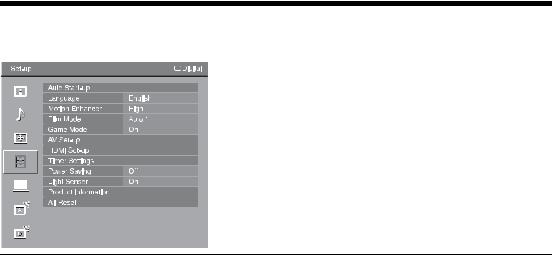
Set-up menu
You can select the options listed below on the “Setup” menu. To select options in “Settings”, refer to “Navigating through menus” (page 20).
Auto Start-up |
Starts the initial set-up to select the language and country/region, and tune in all |
|
available digital and analogue channels. |
|
Usually, you do not need to do this operation because the language and country/ |
|
region will have been selected and channels already tuned when the TV was first |
|
installed (page 5). |
|
However, this option allows you to repeat the process (e.g. to retune the TV after |
|
moving house, or to search for new channels that have been launched by |
|
broadcasters). |
|
|
Language |
Selects the language in which the menus are displayed. |
|
|
Motion Enhancer |
Provides smoother picture movement and reduces picture blur. |
|
“High”: Provides smoother picture movement such as for film-based contents. |
|
“Standard”: Provides smooth picture movement. Use this setting for standard use. |
|
“Off”: Use this setting when the “High” and “Standard” settings result in noise. |
|
~ |
|
• Depending on the video, you may not see the effect visually, even if you have changed the |
|
setting. |
|
• When you select Theatre Mode, “Motion Enhancer” is set to “Off” by default. |
|
|
Film Mode |
Provides smoother picture movement when playing DVD or VCR images taken on |
|
film, reducing picture blur and graininess. |
|
“Auto 1”: Provides smoother picture movement than the original film-based |
|
content. Use this setting for standard use. |
|
“Auto 2”: Provides the original film-based content as is. |
|
“Off”: Turns off the “Film Mode” feature. |
|
~ |
|
If the image contains irregular signals or too much noise, “Film Mode” will be automatically |
|
turned off even if “Auto 1” or “Auto 2” is selected. |
|
|
Game Mode |
Depending on the game software, select “On” when reaction time is important. |
|
|
26 GB

AV Set-up |
AV Preset |
Assigns a name to any equipment connected to the side and rear sockets. The name will be displayed briefly on the screen when the equipment is selected. You can skip input signals from connected equipment that you do not want displayed on the screen.
1Press F/f to select the desired input source, then press  .
.
2Press F/f to select the desired option below, then press  .
.
Equipment labels: Uses one of the preset labels to assign a name to connected equipment.
“Edit:”: Creates your own label. Follow steps 2 to 4 of “Programme Labels” (page 31).
“Skip”: Skips an unnecessary input source.
Auto S Video
Selects the input signal from S video sockets
 6 when
6 when 
 /
/ 6 sockets are both connected.
6 sockets are both connected.
AV2 Output
Sets a signal to be output through the socket labelled  /
/

 2 on the rear of the TV. If you connect a VCR or other recording equipment to the
2 on the rear of the TV. If you connect a VCR or other recording equipment to the  /
/

 2 socket, you can then record from the equipment connected to other sockets of the TV.
2 socket, you can then record from the equipment connected to other sockets of the TV.
“TV”: Outputs a broadcast.
“AV1”: Outputs signals from equipment connected to the  /
/

 1 socket. “AV6”: Outputs signals from equipment connected to the
1 socket. “AV6”: Outputs signals from equipment connected to the 
 /
/ 6 socket. “Auto”: Outputs whatever is being viewed on the screen (except signals from the
6 socket. “Auto”: Outputs whatever is being viewed on the screen (except signals from the


 /
/ 3, HDMI IN 4, HDMI IN 5, HDMI IN 7 and PC
3, HDMI IN 4, HDMI IN 5, HDMI IN 7 and PC 

 /
/ sockets).
sockets).
Speaker
Turns on/off the TV’s internal speakers.
“TV Speaker”: The TV speakers are turned on in order to listen to the TV’s sound through the TV speakers.
“Audio System”: The TV speakers are turned off in order to listen to the TV’s sound only through your external audio equipment connected to the audio output sockets. When connected with an HDMI control compatible equipment, you can turn the connected equipment on interlocked with the TV. This setting must be made after connecting the equipment.
Audio Out
“Variable”: The audio output from your audio system can be controlled by the TV’s remote.
“Fixed”: The audio output of the TV is fixed. Use your audio receiver’s volume control to adjust the volume (and other audio settings) through your audio system.
~
“Audio Out” is not available for audio system connected to the TV using the HDMI sockets.
Colour System
Selects the colour system (“Auto”, “PAL”, “SECAM”, “NTSC3.58”, “NTSC4.43” or “PAL60”) according to the input signal from the input source.
Functions MENU Using
Continued
27 GB

HDMI Set-up |
This is used to set the HDMI control compatible equipment connected to the HDMI |
|
|
sockets. Note that the interlock setting must also be made on the connected HDMI |
|
|
control compatible equipment side. |
|
|
HDMI Control |
|
|
Sets whether to interlock the HDMI control compatible equipment and the TV. |
|
|
When set to “On”, the following menu items can be performed. |
|
|
Auto Devices Off |
|
|
When this is set to “On”, the HDMI control compatible equipment turn off |
|
|
interlocked with the TV. |
|
|
Auto TV On |
|
|
When this is set to “On”, the TV turns on interlocked with the HDMI control |
|
|
compatible equipment. |
|
|
Device List Update |
|
|
Creates or updates the “HDMI Device List”. Up to 11 HDMI control compatible |
|
|
equipment items can be connected, and up to 5 equipment items can be connected to |
|
|
a single socket. Be sure to update the “HDMI Device List” when you change the |
|
|
HDMI control compatible equipment connections or settings. |
|
|
HDMI Device List |
|
|
Displays the connected HDMI control compatible equipment. |
|
|
~ |
|
|
You cannot use “HDMI Set-up” when an HDMI control compatible audio system is interlocked |
|
|
with the TV. |
|
|
|
|
Timer Settings |
Sets the timer to turn on/off the TV. |
|
|
Sleep Timer |
|
|
Sets a period of time after which the TV automatically switches itself into standby |
|
|
mode. |
|
|
When “Sleep Timer” is activated, the (Timer) indicator on the TV front panel |
|
|
lights up in orange. |
|
|
z |
|
|
• If you turn off the TV and turn it on again, “Sleep Timer” is reset to “Off”. |
|
|
• A notification message appears on the screen one minute before the TV switches to standby |
|
|
mode. |
|
|
On Timer |
|
|
Sets the timer to turn on the TV from standby mode. |
|
|
“Day”: Selects the day on which you want to activate the “On Timer”. |
|
|
“Time”: Sets the time to turn on the TV. |
|
|
“Duration”: Selects the time period after which the TV automatically switches to |
|
|
standby mode again. |
|
|
“Volume Set-up”: Sets the volume for when the timer turns on the TV. |
|
|
Clock Set |
|
|
Allows you to adjust the clock manually. When the TV is receiving digital channels, |
|
|
the clock cannot be adjusted manually since it is set to the time code of the |
|
|
broadcasted signal. |
|
|
|
|
Power Saving |
Selects the power saving mode to reduce the power consumption of the TV. |
|
|
When “Picture Off” is selected, the picture is switched off and the |
(Picture Off) |
|
indicator on the TV front panel lights up in green. The sound remains unchanged. |
|
|
|
|
28 GB

Light Sensor |
“On”: Automatically optimizes the picture settings according to the ambient light in |
|
the room. |
|
“Off”: Turns off the “Light Sensor” feature. |
|
~ |
|
Be sure not to put anything over the sensor, as its function may be affected. See page 10 for |
|
further information on the sensor. |
|
|
Product Information |
Displays your TV’s product information. |
|
|
All Reset |
Resets all settings to the factory settings and then displays the “Auto Start-up” |
|
screen. |
~
•Be sure not to turn the TV off during this period (it takes about 30 seconds) or press any buttons.
•All settings, including Digital Favourite list, country/region, language, auto tuned channels, etc. will be reset.
Functions MENU Using
29 GB
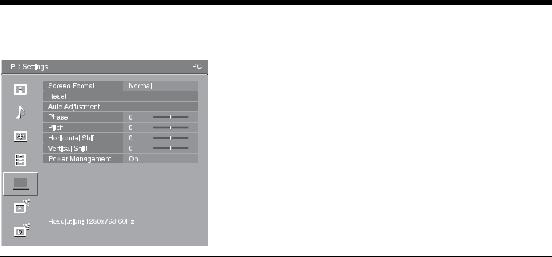
PC Settings menu
You can select the options listed below on the “PC Settings” menu. To select options in “Settings”, refer to “Navigating through menus” (page 20).
Screen Format |
Selects a screen format for displaying input from your PC. |
|
“Normal”: Displays the picture in its original size. |
|
“Full 1”: Enlarges the picture to fill the display area, keeping its original horizontal- |
|
to-vertical aspect ratio. |
|
“Full 2”: Enlarges the picture to fill the display area. |
|
|
Reset |
Resets the PC settings except “Screen Format” and “Power Management” to the |
|
factory settings. |
|
|
Auto Adjustment |
Automatically adjusts the display position and phase of the picture when the TV |
|
receives an input signal from the connected PC. |
|
z |
|
“Auto Adjustment” may not work well with certain input signals. In such cases, manually |
|
adjust “Phase”, “Horizontal Shift” and “Vertical Shift”. |
|
|
Phase |
Adjusts the phase when the screen flickers. |
|
|
Pitch |
Adjusts the pitch when the picture has unwanted vertical stripes. |
|
|
Horizontal Shift |
Adjusts the horizontal position of the picture. |
|
|
Vertical Shift |
Adjusts the vertical position of the picture. |
|
|
Power Management |
Switches the TV to standby mode if no signal is received for 30 seconds. |
|
|
30 GB
